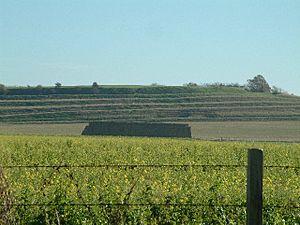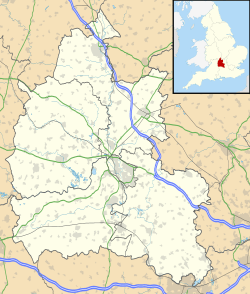Blewburton Hill facts for kids

Lynchets on the west side of Blewburton Hill, Oxfordshire
|
|
| Location | Oxfordshire |
|---|---|
| Coordinates | 51°34′19″N 1°12′43″W / 51.572°N 1.212°W |
| History | |
| Periods | Iron Age |
| Site notes | |
| Excavation dates | 1947–49 & 1967 |
| Public access | Yes (western part) |
| Official name | Blewburton Hill |
| Type | Hillfort |
| Reference no. | 1006301 |
Blewburton Hill is an ancient hillfort in Oxfordshire, England. It was built during the Iron Age, a time when people used iron tools. This hillfort had a single strong wall, called a rampart.
The area around the hillfort is mostly farmland today. There are also some small wooded areas. People may have lived at Blewburton Hill from about 400 BC to 100 BC. Before the hillfort, there was a smaller village here. It was protected by a wooden fence, called a stockade. This first village was built around 500 or 600 BC.
The site changed a lot over time. First, there was a small settlement with a wooden fence. This was around 550 BC. Later, around 400 BC, a larger hillfort was built. It had a single rampart and a shallow ditch. After being empty for a while, the fort was made stronger around 100 BC. Its ditch was made much deeper. The fort was finally left around 50 BC. There is some proof that its end was violent. Much later, during the early Anglo-Saxon period, the hilltop was used as a burial ground.
On the west side of the hill, you can see some terraces, called lynchets. We don't know how old they are or what they were for. But they were likely made after the Iron Age.
Contents
Where is Blewburton Hill Located?
Blewburton Hill is found between two villages. These are Aston Tirrold and Blewbury. The site is part of the Aston Upthorpe parish. This area is in the South Oxfordshire district.
What Was Blewburton Hill Like?
The hillfort covers an area of about 4 hectares (about 10 acres). It had a wide entrance on its west side. This entrance was about 11 meters (36 feet) wide. It might have had a walkway over it. A ditch behind the gateway helped protect it. This ditch was later filled in.
Archaeologists found something unusual here. Several horse burials were discovered right inside the entrance. The gateway was set back, creating a path to it. Later, the fort had a double gate. This is shown by holes where wooden posts once stood.
The Strong Walls and Ditches
The main wall, or rampart, was built much later. It came after the first wooden fence. The rampart was originally 6.4 meters (21 feet) wide. It was made of chalk packed tightly. This chalk was held between wooden supports.
Later, the rampart was rebuilt. It had a steep front that dropped into the ditch. The ditch was about 1.5 meters (5 feet) deep at first. But when it was rebuilt, it was made much deeper. It became about 4.5 meters (15 feet) deep.
In some parts, the rampart has been damaged by farming. But in the west, part of it still exists. It looks like a sunken terrace. The ditch there is now a flat area. The hill also has other strange terraces, or lynchets. Their age and purpose are still a mystery.
Life and History at Blewburton Hill
Blewburton Hill seems to have been a busy place. More people lived here than at other hillforts nearby. The site was first settled around 550 BC. It started as a small group of huts. These huts were inside a wooden fence. This early settlement was about half the size of the later fort.
Around 400 BC, the hilltop was made into a fort. A large bank was built around it. The material for this bank came from a ditch dug outside. Wooden posts held the bank in place.
Abandonment and Rebuilding
The fort was left empty for some time. But it was made strong again around 100 BC. The ditch was dug out deeper. The dirt from the ditch was piled onto the old bank. The entrance, which was once 20 meters (66 feet) wide, was made narrower. It became about 7.5 meters (25 feet) wide. The ends of the rampart near the entrance were covered with stone walls. This stone had to be brought from somewhere else.
Around 50 BC, the hillfort was finally abandoned. This might have happened because of the expansion of a group called the Belgae. People who dug at the site found proof of a violent end. The ramparts had fallen down. There were signs of burning. Dead animals were left where they lay.
Later Use as a Cemetery
Many centuries later, the Anglo-Saxons used the inside of the fort. They used it as a cemetery. This cemetery dates to the early Anglo-Saxon period. Archaeologists found 22 buried people there. They also found one cremation. Most of the buried people had items buried with them.
Discoveries at Blewburton Hill
Archaeologists found some very old tools here. They found flint tools from the Stone Age or early Bronze Age. A smooth stone axe was also found near the entrance. Even though Romans didn't live on the hill, some pieces of Roman pottery were found. These pieces date from the 1st century AD and the 3rd–4th centuries AD.
In one Iron Age burial pit, something special was found. The bones of a horse and a dog were buried together. They were found with the bones of a man. Other Iron Age finds include an iron bar used as money. They also found pottery, two shale pendants, and pieces of shale bracelets.
The Anglo-Saxon cemetery also had many interesting items. These "grave goods" included beads made of amber and glass. A spearhead, two bronze brooches, buckles, and knives were found. Some pots were also discovered.
How We Learned About Blewburton Hill
Archaeologists dug at Blewburton Hill several times. The first digs happened between 1947 and 1953. More research was done in 1967. D. W. Harding led the 1967 dig. He looked closely at the ditch and rampart on the north side of the fort.
Images for kids




